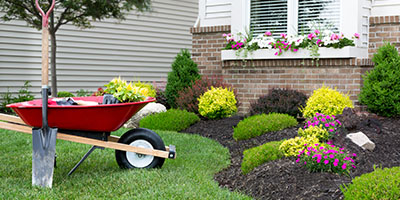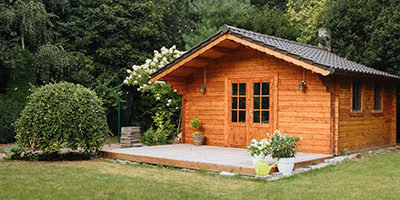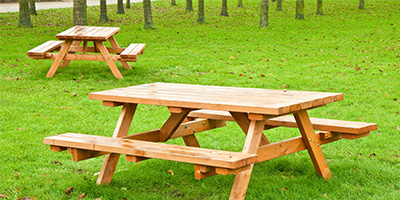The Complete Homeowner’s Guide to Wood Deck Maintenance

Guide to Deck Maintenance
Whether you love having family cookouts or enjoying a quiet cup of coffee and watching the sun rise before the kids get up, decks are a great way to add some outdoor space to your home. However, decks are also subject to the harsh seasons and need lots of TLC throughout the year to keep them safe and looking great. Learn how to care for your wood deck for each season and keep it a serene retreat instead of an eyesore.
Maintenance Tips to Keep Your Wood Deck Looking Great
For many areas, warm temperatures only last six months or less, leaving your deck to face hasher elements for the remaining months as the seasons change. The good news is, if you focus on caring for your wood deck throughout the year, you can help preserve its lifespan and keep it from looking weathered.
1. Combat the Top Causes of Deck Wood Deterioration
Depending on where you live, the causes of deck wear and tear may vary, but these are the top three culprits:
- Water: Moisture will cause your deck wood to expand and contract when dry. This is the reason you’ll get cracked or split boards, popped nails or fasteners and rot. Prevention is as easy as sweeping your deck, clearing away puddles after large rains and removing dirt and leaves.
- Sun: UV rays can break down the bonds between wood cells which not only lightens the pigment of your deck, but also weakens it. This only affects the surface of the wood, so the best maintenance to prevent sun damage is a good coat of stain or sealant.
- Insects: The best way to combat insects from destroying your wood is to trim all your trees and shrubs away from the deck, remove standing water and make sure your deck is sealed. Using yellow bug lights around your deck may also help keep the pests away.
2. Inspect Your Deck
Part of maintaining your wood deck is to inspect it yearly. Before you begin, clear the deck of any furniture or toys and sweep away larger debris.
Deck Inspection Checklist
- Inspect the ledger: Using your flashlight, check the underside of your deck. Make sure to pay attention to the metal flashing that attaches your deck to your home. Look for signs of water damage where your deck connects to your house. You may need to replace if you spot any standing water or deterioration.
- Check all joists, posts and beams: While you’re down there, check the structural parts of your deck. Look for signs of rot on posts and joists and study all the hardware, making note of what’s seriously rusted and needs to be replaced.
- Search for cracks, rotting deck boards or protruding nails: Walk around the deck to listen for squeaks. Feel for soft spots or sagging areas and make note of any cracks or loose nails that need repair.
- Examine the railing and stairs: Give your railing a good shake to make sure posts aren’t loose or damaged. Check for cracks that may have developed around nails or screws.
- Look for signs of rot: Examine structural boards with a flat-blade screwdriver. Start by checking the stairs, especially where the stringers – the saw-tooth notched pieces that support the steps – meet the ground. Check each perimeter post. If you can push the screwdriver a quarter-inch or more into an area, it probably has rot.

Pro Tip
If the spot with rot is smaller than a silver dollar, it can be removed and treated with wood preservative. A larger area may require the structural member to be replaced and you’ll need to contact a professional.
When You Should Do This: Late spring or early summer when the weather is dry
Tools Needed: Flat-blade screwdriver, flashlight
Cost: Free
Don’t have a screwdriver set?
Check out our guide of essential tools every homeowner and DIYer should have in their toolbox!
Building Codes for Decks
During your annual deck inspection, it’s important to not only make sure it’s structurally safe, but also up to code. Some requirements to keep your eye out for during your inspection are:
Support:
- Deck must be able to support 40 pounds per square foot.
Wood Type:
- The lumber your deck is made of must be treated to resist decay.
Railing and Guardrails:
- Railing must be at least 36 inches minimum in height.
- Guardrails must be strong enough to withhold 200 pound concentrated load.
- There must be a 4 inch minimum gap between deck and underside of bottom rail and between balusters.
Hardware and Flashing:
- All hardware and fasteners must be corrosion resistant.
- A metal flashing is required where your deck connects to your home to prevent water damage.
Stairs:
- Open risers – maximum opening of four inches.
- Closed risers – minimum one-inch thick riser material.
- A minimum of 26 inches at all points above the permitted handrail height.
- If handrail is only on one side – minimum 31.5 inches width below handrail height.
- If handrail is on both sides – minimum 27 inches width below handrail height.
Wondering if the rest of your home is up to code? Check out the most common housing code violations.
3. Replace Rotten Deck Boards
Replacing deck boards can be thought of as performing surgery on your deck if you’re replacing one rotten board amongst other healthy ones. Make sure you know what species your deck wood is so you can try to closely match the existing boards.
- Cut the section of bad board free from the joists at both ends.
- Remove the nails and rotted board.
- Install nailing cleats for support.
- Lay flashing over the decaying joists.
- Insert new deck boards cut to correct length.

Pro Tip
Flatten the tip of the nail or deck screw before driving it into the board to reduce splitting.
You may want to enlist some help for this DIY project or hire the help of a professional to make sure you are safely replacing the boards and your updated deck will be up to code.
When You Should Do This: Late spring or early summer when the weather is dry
Tools Needed: Long replacement deck boards, tape measure, circular saw, drill, hammer, pry bar, safety glasses, hearing protection, extension cord
Cost: $21 a day circular saw rental, $150 for additional tools, about $25 per replacement board
Not sure how to get rid of your rotted deck boards?
Check out our Bulk Waste Disposal Guide!
4. Fix Loose Nails
A very common issue with wood decks involves deck nails and screws popping up out of the boards. They should be fixed quickly not only to maintain the integrity of the deck, but also for safety reasons. Nails most often pop out of the wood because of extremely hot or cold weather.
You have two options for fixing loose deck nails:
- Hammer the popped nails back down. This is only a temporary solution because since the nail popped out, the hole has become slightly larger and the chances of it popping out again are high.
- Remove the popped nail. You can line the new nail up near – but not in – the previous hole and hammer it in place. To ensure the nail doesn’t pop again, place a deck screw next to the new nail you just drove into the deck. Make sure the deck screw is close enough so that head of the screw partially covers the top of the nail.
When You Should Do This: Spring or summer
Tools Needed: Hammer, nails, deck screws
Cost: $9-$11 for hardware
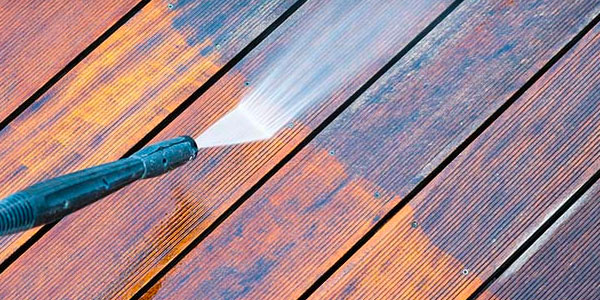
5. Clean and Stain Your Deck
Washing away the residue from fall and winter is essential to starting off your outdoor season on the right foot to avoid mold and mildew, which can cause rot.
If you are using a pressure washer, make sure you are using the lowest possible pressure that will still be effective. Pressure for soft wood, like pine or cedar, should be 500 to 600 pounds per square inch. It’s a good idea to test an inconspicuous area like a stair tread to make sure it won’t damage your wood.
When You Should Do This: Spring
Tools Needed: Pressure washer (you can rent one from your local home improvement store)
Cost: Around $26 for a four-hour minimum
Deck Sealer vs. Deck Stain
Deck sealer and deck stain may seem to serve the same purpose to protect your wood from the elements, but they do offer different benefits.
A deck sealer is a clear coat you can apply to your wood deck to help prevent water from penetrating your boards. While it is a great moisture repellent, it does not protect from the sun’s harmful UV rays, which can dry out your deck boards, causing cracking and splintering. Your sealer will need to be reapplied yearly, but the good news is, it’s fairly simple to do yourself.
A deck stain has similar moisture protection qualities, but also offers UV protection. The darker the color of stain you choose, the more your wood will be shielded from the harmful rays. Wood stain is more expensive than sealer, but it lasts up to five times longer and looks more professional when applied correctly.
When You Should Do This: Late spring or early summer
Tools Needed: The stain or sealant of your choice, paint roller, paint brush, protective gloves
Cost: Around $45 per gallon of stain, $35 per gallon of sealer, $30 for tools
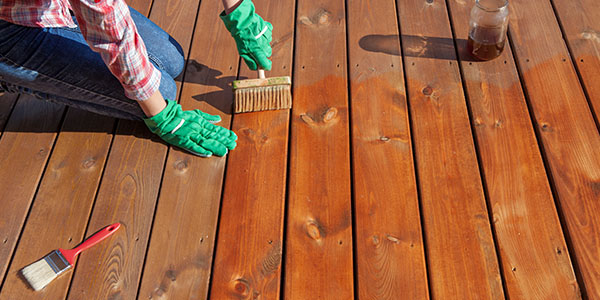
Deck Staining Tips
- Make sure your deck is clean and dry. Sweep it thoroughly and use a screwdriver or other small tool to clean out debris between decking boards.
- Check the forecast ahead of time to make sure you have several dry days ahead.
- Apply stain when the temperature is between 50 and 90 degrees.
- Stick painter’s tape on any surfaces surrounding your deck, such as siding, that you want to protect.
- Spread the stain onto your deck using a natural bristle paint brush to force the stain into the grains and pores of your wood.
6. Protect Your Deck From the Winter Weather
Preparing your deck to survive the harsh winter weather is important to keep it looking healthy for the next warm season. One way to protect it from snow and ice is so lay a tarp down before the first snow to create a barrier and prevent warping and moisture buildup. If you forgo the tarp, make sure to shovel your deck to clear off built up snow with a plastic shovel or using a broom.
If your deck isn’t being used as an entrance or exit to your home, you can usually skip shoveling and let the snow melt. If you do choose to shovel, make sure to do it parallel to the deck boards to avoid damage.
Avoid using salt or ice melting products on your wood deck to avoid any damage to your finish or discoloration. If you can’t avoid it, a good option for ice removal that will be safer for your wood deck is a calcium chloride-based ice melt that is safe for pets, wood and the environment.
When You Should Do This: Winter
Tools Needed: Plastic shovel or broom, tarp and calcium chloride-based ice melt
Cost: $50 for 20-by-30-foot tarp, $87 for 25-pound bucket of ice melt
Maintaining Different Deck Wood Types
While all wood decks require some type of maintenance, the species of wood that your deck was built with can impact the way you maintain it. It’s important to take the time to know what your deck is built from and how to care for it long-term.
Pressure-Treated Wood
While this wood is a cost-effective option, it is high-maintenance and needs to be power washed, stained and sealed annually or bi-annually. The boards do shrink in size over time, which can cause cracking and splintering. It may not be the best option for families with pets or children, because the splinters can cause infections due to the chemicals the boards are treated with.
Soft Woods
Redwood and cedar are two popular soft wood possibilities that are a step up from pressure-treated lumber. These woods are naturally rot resistant, but like any other decking material, the elements can cause natural wear and tear, so soft wood decks need to be cleaned and sealed annually.
Hard Woods
Hard wood decking options usually outperform pressure-treated wood or soft wood in terms of weather resistance and durability. That does mean that the overall cost is slightly higher for woods such as teak, cherry and oak, but they may be a better choice in the long run. You can let your hard-wood deck age and change colors naturally, but if you want to maintain its color, stain the boards with a UV-blocking stain once a year.
When Checking Your Deck, Always Keep Safety in Mind
If your deck is beyond an eyesore, it may not be safe for you or your family to use anymore. You may want to consider tearing it down and starting fresh. Our step-by-step guide to removing your deck will help even the most beginner handyman tackle this project.

